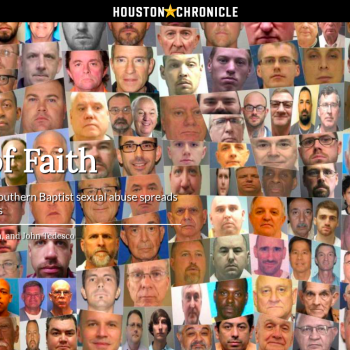 Much of the news coming out of the SBC has been negative lately, with declining numbers and baptisms. (The only growing baptism age group is those under 5, because we don’t practice infant baptism, but apparently we’re great at toddler baptism). From 2013-2014 a Pastors’ Task Force was assembled to address the glaring fact that most Southern Baptist churches baptize almost no Millenials. They identified five problems and advocated five solutions (read their full report here). They got it half right. Their identification of the problem is spot on. Their solutions, unfortunately, are the same recycled ideas that got us here in the first place.
Much of the news coming out of the SBC has been negative lately, with declining numbers and baptisms. (The only growing baptism age group is those under 5, because we don’t practice infant baptism, but apparently we’re great at toddler baptism). From 2013-2014 a Pastors’ Task Force was assembled to address the glaring fact that most Southern Baptist churches baptize almost no Millenials. They identified five problems and advocated five solutions (read their full report here). They got it half right. Their identification of the problem is spot on. Their solutions, unfortunately, are the same recycled ideas that got us here in the first place.
We have a Spiritual Problem. Many of our SBC pastors and churches are not effectively engaged in sharing the gospel and yet continue business as usual. We need a sense of brokenness and repentance over the spiritual climate of our churches and our nation.
So far so good. Too many churches are stuck in the same patterns of traditionalism, neglecting effective evangelism. Their solution? “With urgency, we must join together in fervent and effective prayer for spiritual awakening in our churches and our nation.” Prayer here is a cop out! If the problem is business as usual, the answer isn’t to pray about it, the answer is to change things up! Prayer is easy, change is hard. We ran out of easy options awhile ago.
We have a Leadership Problem. Many pastors have confessed to being overwhelmed in the operation and ministries of the church to the neglect of being involved in regular personal evangelism. This lack of leading by example is negatively impacting our church members’ engagement in personal evangelism.
Again, nailed it. Church ministries have become so complex and cumbersome that many pastors have no time or energy to engage in personal evangelism. Their solution? Try harder. “As pastors we must intentionally model and prioritize personal evangelism while providing clear pathways* for our congregations to follow.” What a discouraging solution! It’s telling pastors to work longer, try harder, keep going until you burn out. The right solution is to simplify the organization and structure of the church (i.e. legacy programs and activities that are no longer effective) to create more margin for the pastor to evangelize. If he’s stuck up at the church all week managing programs, telling him to “try harder” will only set up him for failure. (My favorite part of this solution is the *, which is a quick plug for NAMB’s latest one-size-fits-all evangelism tool, because the best way to meet Millenials’ well-documented search for authenticity is with another cookie-cutter evangelism strategy).
We have a Discipleship Problem. Many pastors have confessed to focusing on attendance while giving little attention to reproducing fruit-bearing disciples who are involved in intentional evangelism.
True. Success in church nowadays is measured purely by attendance, with no thought to discipleship. Their solution is solid without being helpful. “As pastors we must create a disciple-making culture.” Okay, how are we supposed to do that? At least they didn’t urge us to add another program to our already overly-programmed churches.
We have a Next Generation Problem. Although our churches have increasingly provided programs for children, students and young adults, we are not being effective in winning and discipling the next generation to follow Christ.
Again true. We have programs galore for kids and teens, but we’re still losing kids and teens. Their solution? More programs! “As pastors we must leverage our influence, activity and resources to reach and make disciples of the Next Generation. We must renew our focus on equipping parents and church leaders— challenging them to make the claims of Christ clear to the Next Generation.” Equipping parents is vital, but reaching the next generation isn’t as difficult as people think. That’s been my world for over a decade. I’ve been on both sides of it now: youth pastor and senior pastor, and am convinced that the first step to reaching the next generation is as simple as making a Sunday morning experience that the next generation actually wants to come to. Shoving them into next gen friendly programs while maintaining an archaic Sunday morning worship service will never effectively reach the next generation.
We have a Celebration Problem. Many of our churches have chosen to celebrate other things as a measure of their success rather than new believers following Christ in baptism. We have drifted into a loss of expectation.
This is the one problem/solution they got spot on. Baptism needs to be a truer celebration, not a quick ‘tack-on’ to the beginning of the service. “We must establish an ethos of joy that celebrates the practice of personal evangelism and its fruit.” Baptism needs to be a big deal. That’s why at Mt Vernon we video everyone’s baptism testimony and take time out during the middle of the service (not the beginning or end) to celebrate together.
All in all, I think they nailed the problems without offering fresh or effective solutions. It’s the same stuff our leadership has been saying for years: “Try harder.” We don’t need to try harder, we need to try something different. But since this is the best and the brightest that our denomination has put forth, I guess we’ll keep racking up those toddler baptisms for the foreseeable future.
**Full Disclosure: Last year, Mt Vernon (average attendance 350) baptized 6 Millennials. We’re not knocking it out of the park by any means, but those numbers would make us one of the more effective Southern Baptist churches when it comes to baptizing Millennials.











